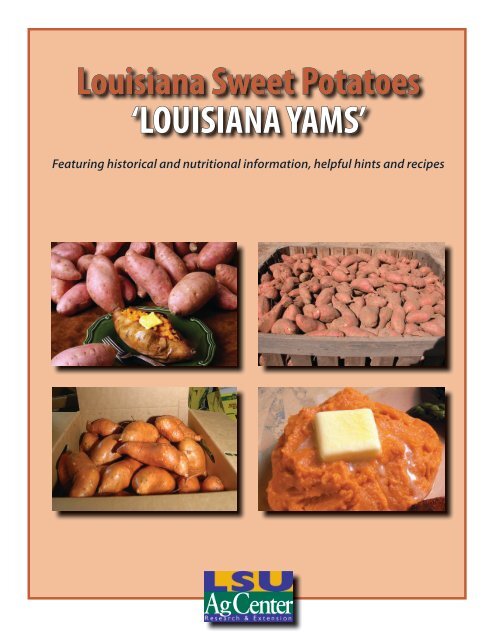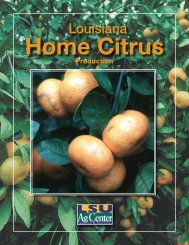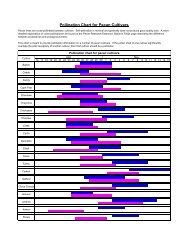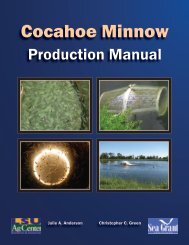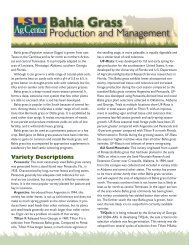Louisiana Sweet Potatoes 'LOUISIANA YAMS' - The LSU AgCenter
Louisiana Sweet Potatoes 'LOUISIANA YAMS' - The LSU AgCenter
Louisiana Sweet Potatoes 'LOUISIANA YAMS' - The LSU AgCenter
You also want an ePaper? Increase the reach of your titles
YUMPU automatically turns print PDFs into web optimized ePapers that Google loves.
<strong>Louisiana</strong> <strong>Sweet</strong> <strong>Potatoes</strong><br />
‘LOUISIANA YAMS’<br />
Featuring historical and nutritional information, helpful hints and recipes<br />
1 <strong>LSU</strong> <strong>AgCenter</strong> Pub. 3184 <strong>Louisiana</strong> <strong>Sweet</strong> <strong>Potatoes</strong> — ‘<strong>Louisiana</strong> Yams’
History<br />
<strong>Louisiana</strong> sweet potatoes or <strong>Louisiana</strong> yams, as<br />
they have come to be known, are bred to have a soft,<br />
moist flesh, to be exceptionally sweet and flavorful and<br />
to be very high in beta carotene or vitamin A value.<br />
<strong>The</strong> successful golden sweet potatoes are the<br />
result of extensive research programs conducted by<br />
Experiment Station scientists of the <strong>Louisiana</strong> State<br />
University Agricultural Center.<br />
<strong>Sweet</strong> potatoes have been part of the landscape<br />
of <strong>Louisiana</strong> for more than 200 years, but it was not<br />
until 1937 that they began to be marketed nationally<br />
as <strong>Louisiana</strong> yams. Much of the creation of the<br />
<strong>Louisiana</strong> sweet potato industry can be credited to an<br />
outstanding scientist, the late Dr. Julian C. Miller, and his<br />
colleagues in the horticulture department of <strong>Louisiana</strong><br />
State University. <strong>The</strong>y chose to call this moist-flesh<br />
sweet potato the <strong>Louisiana</strong> yam to distinguish it from<br />
the many other sweet potato varieties grown elsewhere<br />
at that time.<br />
Research efforts have continued, and several<br />
important sweet potato varieties have been developed<br />
through cooperative efforts of scientists and extension<br />
personnel of the <strong>LSU</strong> <strong>AgCenter</strong> with cooperation from<br />
producers and others in the <strong>Louisiana</strong> sweet potato<br />
industry.<br />
<strong>The</strong> Beauregard variety, which was developed by<br />
<strong>LSU</strong> <strong>AgCenter</strong> scientists, now accounts for about 90<br />
percent of the sweet potato production in <strong>Louisiana</strong>.<br />
But the Evangeline <strong>Sweet</strong> Potato variety, which was<br />
released by the <strong>LSU</strong> <strong>AgCenter</strong> in 2007, also is gaining<br />
popularity.<br />
Evangeline has a bright orange flesh and is high<br />
in sucrose, which makes it a great tasting sweet potato.<br />
<strong>The</strong> Evangeline variety currently represents about 10<br />
percent of <strong>Louisiana</strong>’s sweet potato acreage, but that<br />
number is expected to increase over the next few years.<br />
<strong>The</strong> economic importance of <strong>Louisiana</strong> yams<br />
is noted by their worldwide distribution. <strong>The</strong>y are<br />
marketed not only fresh but also through various<br />
processing sectors.<br />
2 <strong>LSU</strong> <strong>AgCenter</strong> Pub. 3184 <strong>Louisiana</strong> <strong>Sweet</strong> <strong>Potatoes</strong> — ‘<strong>Louisiana</strong> Yams’<br />
Nutrition<br />
According to the U.S. Department of Agriculture’s<br />
Agricultural Research Service, sweet potatoes often<br />
are called a “nutritional powerhouse” because they<br />
are very high in beta carotene. <strong>The</strong> deep orange color<br />
of the sweet potatoes indicates it is rich in carotene,<br />
which becomes vitamin A inside the body. Vitamin A is<br />
needed for normal growth, development, reproduction,<br />
a healthy immune system and vision. One mediumsize<br />
baked sweet potato provides about twice the<br />
recommended daily amount of vitamin A.<br />
<strong>Sweet</strong> potatoes also are a good source of dietary<br />
fiber, vitamin B6, potassium and vitamin C when baked<br />
in the skin. <strong>The</strong>y are low in sodium, fat and saturated<br />
fat. One medium-size baked sweet potato has only 103<br />
calories.<br />
Cured vs. Uncured<br />
Freshly dug sweet potatoes that reach the market<br />
in late summer and early fall are uncured. Fresh,<br />
uncured potatoes may be available at farmers markets.<br />
<strong>The</strong>y are good boiled, mashed, candied, fried and in<br />
many cooked dishes, but uncured potatoes do not bake<br />
successfully.<br />
Freshly harvested sweet potatoes must be cured<br />
before they will bake successfully. During the curing<br />
time, the starch is converted to sugar, making the<br />
potatoes sweet and moist. Typically, sweet potatoes<br />
are cleaned after harvest and then cured and stored<br />
until they are ready to be transported to market.<br />
Commercially, they are kiln dried. Cured or kiln-dried<br />
sweet potatoes usually come to the market in late fall<br />
just before Thanksgiving. <strong>The</strong>y are delicious baked or<br />
prepared in any manner.<br />
<strong>Sweet</strong> potatoes may be cured by holding them<br />
for about 10 days at 80-85 degrees Fahrenheit with<br />
high relative humidity (85-90 percent) and good<br />
air circulation. <strong>The</strong>y also may be cured at lower<br />
temperatures of 65-75 F for two to three weeks.
Selection<br />
Fresh: When buying fresh sweet potatoes, choose<br />
well-shaped, firm potatoes with smooth, bright,<br />
uniformly colored skins. Avoid sweet potatoes with<br />
holes or cuts that penetrate the skin, since those cause<br />
decay.<br />
Value Added<br />
Frozen: Value-added frozen sweet potatoes<br />
have become increasingly popular in recent years and<br />
are available as fries, slices, halves, patties and puffs.<br />
Directions about how to prepare the various frozen<br />
forms are on the package labels.<br />
Canned: Canned sweet potatoes are available in<br />
several styles – whole, pieces, mashed and with fruit.<br />
Whole or cut sweet potatoes are packed in syrup. Some<br />
are vacuum packed without syrup, and there are lighter<br />
styles that have less sugar. Read the label to choose the<br />
style, amount and brand or grade.<br />
Other: <strong>Sweet</strong> potato chips, biscuit and pancake<br />
mixes, juices, cookies, baby foods, prepared casseroles<br />
and pet food are among the other ways are used.<br />
Storage: Store cured sweet potatoes in a cool, dry<br />
place where the temperature is about 55 to 60 degrees<br />
F. Do not store them in the refrigerator or below 55<br />
degrees F. Chilling a sweet potato will give it a hard core<br />
and an undesirable taste when cooked. Store canned<br />
sweet potatoes in a cool place.<br />
Preparation<br />
Ideally, fresh sweet potatoes should be cooked<br />
within a week or two of being purchased, but they<br />
may be stored for up to one month. Well matured,<br />
carefully handled and properly cured potatoes will<br />
keep for several months if the temperature and storage<br />
conditions are ideal. This usually is not possible,<br />
however, and potatoes spoil easily. You might wish to<br />
cook and freeze them to maintain high quality.<br />
3 <strong>LSU</strong> <strong>AgCenter</strong> Pub. 3184 <strong>Louisiana</strong> <strong>Sweet</strong> <strong>Potatoes</strong> — ‘<strong>Louisiana</strong> Yams’<br />
<strong>Sweet</strong> potatoes can be prepared in dozens of ways<br />
– boiled, microwaved, candied, stuffed, fried, mashed<br />
or whipped – but are especially popular when baked<br />
and served hot with a little margarine or butter. Another<br />
South <strong>Louisiana</strong> favorite is to serve them with gumbo.<br />
<strong>Sweet</strong> potatoes also may be seasoned with sugar and<br />
spices or fruits and included in casseroles and pies or<br />
served in orange shells. <strong>The</strong>y combine well with meats<br />
for main dishes, and they make tasty cakes and pones<br />
and nutritious breads, muffins and cookies. <strong>The</strong>y can<br />
even be used in soup or made into candy!<br />
Baking: To bake sweet potatoes, scrub and dry<br />
well. Rub lightly with oil. Don’t wrap in foil for baking.<br />
(When wrapped in foil, sweet potatoes are steamed,<br />
not baked. That means they will not be syrupy and will<br />
not have the sweet, distinctive flavor of uncovered<br />
sweet potatoes baked in a conventional oven.) Place on<br />
baking sheet. Bake for 15 minutes in oven preheated to<br />
400 degrees F; then reduce temperature to 375 degrees<br />
F and bake until soft (about 1½ hours for medium-size<br />
potatoes).<br />
Save energy by baking a large pan of sweet<br />
potatoes. After baking, wrap individually in foil; then<br />
store together in freezer bag or freezer paper in the<br />
freezer. Reheat foil-wrapped sweet potatoes in the oven<br />
or remove foil and reheat in the microwave.<br />
<strong>The</strong> nutrition information for one medium baked<br />
sweet potato is 103 calories, 23.6 grams carbohydrate,<br />
3.8 grams fiber, 15 grams fat, .03 grams saturated fat, 0<br />
milligrams cholesterol, 41 milligrams sodium, 21,909 IU<br />
vitamin A and 22 milligrams vitamin C.<br />
Another baking/freezing<br />
option: Without peeling the<br />
potatoes, wash, trim and heat them<br />
in oven at 350 F until potatoes are<br />
slightly soft. Cool, remove peel and<br />
wrap individually in aluminum foil.<br />
Place in polyethylene bags and<br />
freeze. Complete the baking in an<br />
oven at 350 F immediately before<br />
serving, leaving the potatoes<br />
wrapped in foil.<br />
Microwaving: <strong>Sweet</strong><br />
potatoes may be cooked, but not<br />
baked, in the microwave oven.<br />
When cooked in the microwave,<br />
they won’t have the sweet, syrupy<br />
flavor of oven-baked potatoes.
Check your local grocer for sweet potatoes that are<br />
individually wrapped for cooking in the microwave.<br />
To microwave, wash sweet potatoes, dry and<br />
puncture each a few times with a fork. Place on a paper<br />
towel or a microwave-safe dish. Cook on high for 4 to 5<br />
minutes for the first potato, plus 2 to 3 minutes for each<br />
additional potato. Turn over potatoes halfway through<br />
cooking.<br />
Boiling: To boil sweet potatoes, boil until tender<br />
with skins on and drain immediately. Peel and eat, or<br />
use in your favorite recipe. Most sweet potato dishes<br />
freeze well. Save time and energy by making a sweet<br />
potato dish to serve and one to store in the freezer.<br />
Freezing: Choose medium to large sweet potatoes<br />
that have been cured for at least one week. Sort<br />
according to size and wash. Cook until almost tender<br />
in water, in steam, in a pressure cooker or in the oven.<br />
Let stand at room temperature until cool. Peel sweet<br />
potatoes, cut in halves, slice or mash.<br />
If desired, to prevent darkening, dip whole sweet<br />
potatoes or slices for 5 seconds in a solution of 1/2 cup<br />
lemon juice to 1 quart water.<br />
To keep mashed sweet potatoes from darkening,<br />
mix 2 tablespoons orange or lemon juice with each<br />
quart of mashed sweet potatoes.<br />
Pack into containers, leaving 1/2-inch headspace.<br />
Seal and freeze.<br />
Ways to add more sweet potatoes<br />
to your meals and snacks:<br />
Pack a baked sweet potato for lunch,<br />
topped with vanilla yogurt or cinnamonflavored<br />
applesauce.<br />
Add peeled chunks to your favorite stew.<br />
Switch from potato chips to sweet potato<br />
chips.<br />
Peel and cut into strips to eat with your<br />
favorite dip.<br />
Blend into a breakfast smoothie.<br />
Substitute in recipes calling for white<br />
potatoes or apples.<br />
<strong>Sweet</strong> Potato Pie<br />
Serves 8<br />
2 cups mashed cooked or canned sweet potatoes<br />
1 teaspoon allspice<br />
2 tablespoons low-fat margarine<br />
2 eggs, slightly beaten<br />
3/4 cup sugar (if canned in syrup, use 1/2 cup sugar)<br />
1 cup skim milk<br />
2/3 cup evaporated skim milk<br />
1/2 teaspoon salt<br />
1 teaspoon vanilla<br />
1/2 teaspoon cinnamon<br />
1 plain pastry shell<br />
1/2 teaspoon ginger<br />
3 tablespoons chopped pecans, optional<br />
Cook sweet potatoes, or heat canned potatoes in<br />
syrup until most of the liquid has evaporated.<br />
4 <strong>LSU</strong> <strong>AgCenter</strong> Pub. 3184 <strong>Louisiana</strong> <strong>Sweet</strong> <strong>Potatoes</strong> — ‘<strong>Louisiana</strong> Yams’<br />
Use Versatile<br />
<strong>Louisiana</strong> Yams<br />
in Healthier Meals<br />
Beat potatoes with mixer, if available. Thoroughly<br />
mix in margarine, sugar, salt and spices. Add eggs, milk,<br />
evaporated milk and vanilla; mix well. Do not scrape<br />
beaters; the fibers have matted together on the beater.<br />
Pour into 9-inch pastry-lined pie pan (have edges<br />
crimped high). Sprinkle pecans on top. Bake in hot oven<br />
at 425 degrees F for 10 minutes. Reduce temperature to<br />
350 degrees F and bake 25-30 minutes longer or until<br />
firm around edges but still a little soft in center. Center<br />
will get firm as pie cools. Especially good with pecans.<br />
Each serving provides: 319 calories, 13.5 grams fat,<br />
3.1 grams saturated fat, 87 miligrams cholesterol, 49.9<br />
grams carbohydrates, 1.3 grams fiber, 296 milligrams<br />
sodium, 4,885 IU vitamin A and 9 milligrams vitamin C.<br />
Variation: Place<br />
pie mixture in a<br />
casserole dish or in<br />
orange cups and bake<br />
at 350 degrees F. Top<br />
with marshmallows<br />
and run under broiler.
Fruited <strong>Sweet</strong> Potato Cups<br />
16 servings<br />
8 oranges<br />
6 medium sweet potatoes (or 2-pound can)<br />
1/2 stick low-fat, no-salt margarine<br />
1/2 cup sugar<br />
1/2 cup orange juice<br />
1 small can crushed pineapple, canned in own juice<br />
1 small bottle maraschino cherries, chopped<br />
1/4 cup cherry juice<br />
1 teaspoon vanilla<br />
1/2 teaspoon almond flavoring<br />
1/4 teaspoon salt<br />
1/4 cup chopped pecans<br />
small marshmallows<br />
Cut oranges in half. Juice, saving part of juice<br />
for potatoes. Remove pulp and white membrane<br />
by scraping with spoon. Scallop or flute edges with<br />
scissors. Bake or boil sweet potatoes, or heat canned<br />
sweet potatoes. Remove skins while hot and mash. Add<br />
margarine, sugar, orange and cherry juices and beat<br />
well. Do not scrape beaters; the fibers have matted<br />
together on the beaters. Fold in pineapple and juice,<br />
cherries, flavorings, salt and pecans. Fill orange cups<br />
with potato mixture. Top each with 5 marshmallows.<br />
Put into hot oven or run under broiler to brown<br />
marshmallows.<br />
Each serving provides: 135 calories, 4 grams fat,<br />
0.2 grams saturated fat, 0 milligrams cholesterol, 24.8<br />
grams carbohydrates, 2.1 grams fiber, 1,346 IU vitamin A<br />
and 24 milligrams vitamin C.<br />
Note: Orange shells may be prepared ahead and<br />
stored in refrigerator in plastic bag. Potato mixture may<br />
be prepared ahead or even frozen. Reheat; then fill<br />
orange cups.<br />
<strong>Sweet</strong> Potato-Apple Bisque<br />
with Sage Cream<br />
(Best of Show <strong>Sweet</strong> Potatofest, Winnsboro, 1995)<br />
12 servings<br />
2 tablespoons light margarine<br />
2 cups chopped onions<br />
2 teaspoons minced garlic<br />
3 large sweet potatoes, peeled and cut into chunks<br />
4 large apples, peeled and sliced<br />
4 cups fat-free, reduced-sodium chicken broth<br />
1 tablespoon sage<br />
1/4 teaspoon pepper<br />
Cook onions and garlic in margarine over medium<br />
heat until onions are yellow (about 5 minutes). Add<br />
potatoes and apples. Cook about 3 minutes, stirring<br />
occasionally. Add broth and seasonings. Bring to a boil.<br />
Cover and simmer on low heat for about 30 minutes.<br />
Puree’ mixture in blender or food processor. Serve hot<br />
with a dollop of sage cream (recipe follows).<br />
Each serving provides: 108 calories, 3.5 grams fat,<br />
0.2 grams saturated fat, 0 milligrams cholesterol, 17<br />
grams carbohydrate, 341 milligrams sodium, 10,875 IU<br />
vitamin A and 18 milligrams vitamin C.<br />
Sage Cream<br />
1/2 cup sour cream (low-fat)<br />
1 teaspoon sage<br />
1 tablespoon apple juice<br />
1/4 teaspoon each salt and pepper<br />
Mix and drizzle over hot soup.<br />
5 <strong>LSU</strong> <strong>AgCenter</strong> Pub. 3184 <strong>Louisiana</strong> <strong>Sweet</strong> <strong>Potatoes</strong> — ‘<strong>Louisiana</strong> Yams’
Fat-Free <strong>Sweet</strong> Potato Muffins<br />
Makes about 18 muffins<br />
2 1/4 cups all-purpose flour<br />
1/2 cup sugar<br />
1/3 cup light brown sugar<br />
1 teaspoon cinnamon<br />
1/4 teaspoon ginger<br />
1 teaspoon salt<br />
1 teaspoon baking powder<br />
1/2 teaspoon baking soda<br />
1 1/2 cups shredded sweet potatoes<br />
1/2 cup raisins<br />
1 8-ounce carton nonfat vanilla yogurt<br />
1/2 cup nonfat egg substitute<br />
1 teaspoon vanilla<br />
1 teaspoon confectioners’ sugar (dust on top after<br />
baking)<br />
Sift dry ingredients. Fold in grated sweet potatoes<br />
and raisins. Mix yogurt, egg substitute and vanilla. Mix<br />
lightly with dry ingredients. Spray muffin tins with nostick<br />
cooking spray and fill two-thirds full of batter. Bake<br />
at 400 degrees F for about 20 minutes or until done.<br />
Makes about 18 muffins. As an alternative, bake in loaf<br />
pan (4 ½ inches by 8 1/2 inches) about 50 minutes at<br />
350 degrees F.<br />
Each muffin provides: 146 calories, 32 grams<br />
of carbohydrates, 0.5 grams fiber, 0 milligrams fat, 0<br />
milligrams saturated fat, 0 milligrams cholesterol, 288<br />
milligrams sodium, 2,216 IU vitamin A and 2 milligrams<br />
vitamin C.<br />
Betty Bagent’s<br />
Candied <strong>Sweet</strong> <strong>Potatoes</strong><br />
Yield: 18 pieces<br />
6 medium sweet potatoes<br />
1 1/2 cups sugar<br />
1 1/2 teaspoons cinnamon<br />
1 1/2 tablespoons flour<br />
1/2 teaspoon salt<br />
1 stick reduced fat margarine<br />
1 lemon, sliced<br />
1/3 cup water<br />
1/2 cup chopped pecans (optional)<br />
Wash potatoes. Peel and cut into circular slices<br />
about 2 inches long — about three slices per potato.<br />
Precook in a little water until barely tender. (Or cover<br />
whole unpeeled potatoes with water and parboil until<br />
barely fork tender — about 15 to 20 minutes. Cool, peel<br />
and cut into 2-inch pieces.) Arrange pieces in a greased<br />
baking dish about 13 inches by 9 inches.<br />
Mix sugar, cinnamon, flour and salt. Sprinkle evenly<br />
over potatoes. Dot with margarine. Twist lemon slices<br />
over potatoes; then arrange lemon peels diagonally<br />
across potatoes. Pour water evenly over potatoes. Add<br />
chopped pecans, if desired. Bake in 400 degrees F oven<br />
until syrup is thick (about 35 to 45 minutes). Baste<br />
occasionally with the syrup during baking.<br />
Each piece (without nuts) provides: 148 calories,<br />
15 grams carbohydrate, 0.7 grams fiber, 2.5 grams fat,<br />
0 milligrams saturated fat, 0 milligrams cholesterol,<br />
103 milligrams sodium, 10,176 IU vitamin A and 16<br />
milligrams vitamin C.<br />
Beauregard <strong>Sweet</strong> <strong>Potatoes</strong> Bonita <strong>Sweet</strong> <strong>Potatoes</strong><br />
6 <strong>LSU</strong> <strong>AgCenter</strong> Pub. 3184 <strong>Louisiana</strong> <strong>Sweet</strong> <strong>Potatoes</strong> — ‘<strong>Louisiana</strong> Yams’
Stuffed <strong>Sweet</strong> <strong>Potatoes</strong><br />
Yields: 8 stuffed potato halves<br />
4 medium sweet potatoes, washed<br />
2 ounces of fresh orange juice<br />
3 teaspoons of margarine, melted<br />
1 tablespoon brown sugar<br />
1/4 teaspoon nutmeg<br />
2 tablespoons chopped pecans<br />
Preheat oven to 375 degrees F. With a fork, prick<br />
holes in sweet potatoes. <strong>The</strong>n bake for 45-60 minutes<br />
or until tender. Remove from oven and cool slightly<br />
for better handling. Once cooled, slice each potato in<br />
half diagonally. Scoop out most of the potato, leaving<br />
approximately 1/4 inch around the skin. Put potatoes<br />
in mixing bowl with orange juice, brown sugar, 2<br />
teaspoons margarine and nutmeg. Whip until smooth.<br />
Place potato skins into a 13-inch-by-9-inch baking<br />
pan and fill with potato mixture. Set aside. In nonstick<br />
frying pan, add remaining margarine (1 teaspoon) and<br />
sauté pecans until toasted. Sprinkle potatoes evenly<br />
with pecans. Bake an additional 15 to 20 minutes until<br />
thoroughly heated.<br />
One serving provides: 86 calories, 2.7 grams fat,<br />
0.4 grams saturated fat, 0 milligrams cholesterol, 10.2<br />
grams fiber, 1.4 grams protein, 14.6 grams carbohydrate,<br />
33 milligrams sodium, 11,090 IU vitamin A and 14.7<br />
milligrams vitamin C.<br />
<strong>Sweet</strong> Potato Bread<br />
Makes 36 quarter-inch slices<br />
2 cups sugar<br />
1/2 cup cooking oil<br />
1 cup egg substitute<br />
3 1/2 cups all-purpose flour<br />
1 1/2 teaspoons baking soda<br />
1/2 teaspoon salt<br />
1 teaspoon cinnamon<br />
1 teaspoon nutmeg<br />
2/3 cup water<br />
2 cups fresh sweet potatoes, cooked and mashed,<br />
or 2 (15-ounce) cans sweet potatoes, drained and<br />
mashed<br />
1/2 cup chopped pecans (optional)<br />
Combine sugar and oil; beat well. Add egg<br />
substitute, and beat. Combine dry ingredients and add<br />
to egg mixture alternately with water. Stir in sweet<br />
potatoes and chopped pecans. Pour into three greased<br />
9-inch-by-5-inch loaf pans. Bake at 350 degrees F for<br />
about one hour. Will freeze well.<br />
One serving without pecans provides: 133<br />
calories, 3.45 grams fat, 0 milligrams saturated fat, 23.7<br />
grams carbohydrate, 0 milligrams cholesterol, 5 grams<br />
fiber, 925 IU vitamin A and 2 milligrams vitamin C.<br />
Evangeline <strong>Sweet</strong> <strong>Potatoes</strong> Murasaki <strong>Sweet</strong> <strong>Potatoes</strong><br />
7 <strong>LSU</strong> <strong>AgCenter</strong> Pub. 3184 <strong>Louisiana</strong> <strong>Sweet</strong> <strong>Potatoes</strong> — ‘<strong>Louisiana</strong> Yams’
<strong>Sweet</strong> Potato Black Bean Salad<br />
with Chili Dressing<br />
Yield: 6 servings<br />
2 large or 3 medium sweet potatoes, chopped into<br />
1-inch pieces<br />
1 medium red onion, chopped<br />
3 teaspoons plus 1 tablespoon olive oil<br />
1 jalapeno chili, cut in half and seeded<br />
1 teaspoon minced garlic from the jar or 1 clove garlic<br />
(peeled)<br />
2 limes, juiced<br />
1 can black beans (15-ounce)<br />
1 medium red or yellow bell pepper, seeded and finely<br />
diced<br />
1 cup chopped fresh cilantro<br />
Wash sweet potatoes. Do not peel. Cut into 1-inch<br />
pieces. Put potatoes into microwave-safe dish, mix<br />
with 2 teaspoons olive oil, cover and cook until tender,<br />
about 5 minutes. <strong>Potatoes</strong> will continue to cook outside<br />
of microwave.<br />
Put onions in microwave-safe dish with cover. Mix<br />
with 1 teaspoon olive oil. Do NOT add water. Microwave<br />
for 2 minutes.<br />
Put chilies in a blender or food processor with<br />
garlic, lime juice, remaining 1 tablespoon olive oil and a<br />
sprinkle of salt and pepper. Process until blended.<br />
Put warm vegetables in a large bowl with beans and<br />
bell pepper. Toss with dressing and cilantro. Taste and<br />
adjust seasoning, if necessary. Serve warm or at room<br />
temperature – or refrigerate for up to one day.<br />
Each serving provides: 223 calories, 34.7 grams<br />
carbohydrate, 10.2 grams fiber, 6.6 grams fat, 0.9 grams<br />
saturated fat, 0 milligrams cholesterol, 297 milligrams<br />
sodium, 12,352 IU vitamin A and 43.5 milligrams vitamin C.<br />
www.<strong>LSU</strong><strong>AgCenter</strong>.com<br />
<strong>Louisiana</strong> State University Agricultural Center<br />
William B. Richardson, Chancellor<br />
<strong>Louisiana</strong> Agricultural Experiment Station<br />
John S. Russin, Interim Vice Chancellor and Director<br />
<strong>Louisiana</strong> Cooperative Extension Service<br />
Paul D. Coreil, Vice Chancellor and Director<br />
Pub. 3184 (1M) 2/11<br />
<strong>The</strong> <strong>LSU</strong> <strong>AgCenter</strong> is a statewide campus of the <strong>LSU</strong> System<br />
and provides equal opportunities in programs and employment.<br />
8 <strong>LSU</strong> <strong>AgCenter</strong> Pub. 3184 <strong>Louisiana</strong> <strong>Sweet</strong> <strong>Potatoes</strong> — ‘<strong>Louisiana</strong> Yams’<br />
<strong>Sweet</strong> Potato Facts We Bet You<br />
Didn’t Know<br />
<strong>The</strong> sweet potato is the basis of one<br />
of <strong>Louisiana</strong>’s important agricultural<br />
industries.<br />
<strong>The</strong> farm value of sweet potatoes exceeds<br />
$50 million, which, in turn, generates over<br />
$100 million for the state’s economy.<br />
About 15,000 acres of sweet potatoes are<br />
grown in the state.<br />
<strong>Louisiana</strong> supplies about 20 percent of all<br />
the sweet potatoes consumed annually in<br />
the United States.<br />
<strong>The</strong> major sweet potato-producing<br />
parishes are Franklin, West Carroll,<br />
Avoyelles, Acadia, Morehouse, Richland, St.<br />
Landry, Evangeline and Rapides.<br />
<strong>The</strong>re are two sweet potato processors<br />
and about 20 fresh-market shippers in the<br />
state.<br />
About 50 percent of the <strong>Louisiana</strong> sweet<br />
potato crop is processed, and 50 percent<br />
goes to the fresh market.<br />
Beauregard and Evangeline are the<br />
predominant varieties grown in <strong>Louisiana</strong><br />
and are excellent varieties for both the<br />
fresh market and processing sectors.<br />
A rigid quality-control program and<br />
grading system have created trade<br />
confidence in <strong>Louisiana</strong>’s sweet potatoes.<br />
<strong>Louisiana</strong>’s high-quality sweet potatoes<br />
bring premium prices over those<br />
from other states in nearly all markets<br />
throughout the United States.<br />
AUTHORS<br />
Elizabeth Reames, Ph.D., R.D., L.D.N.<br />
Professor and Extension Specialist (Nutrition)<br />
School of Human Ecology<br />
Tara Smith, Ph.D., Specialist (<strong>Sweet</strong> <strong>Potatoes</strong>)<br />
and Coordinator, <strong>Sweet</strong> Potato Research Station<br />
Reference: Pub 1843 by<br />
Drs. Ruth M. Patrick (Retired) and Mike Cannon (Retired)


